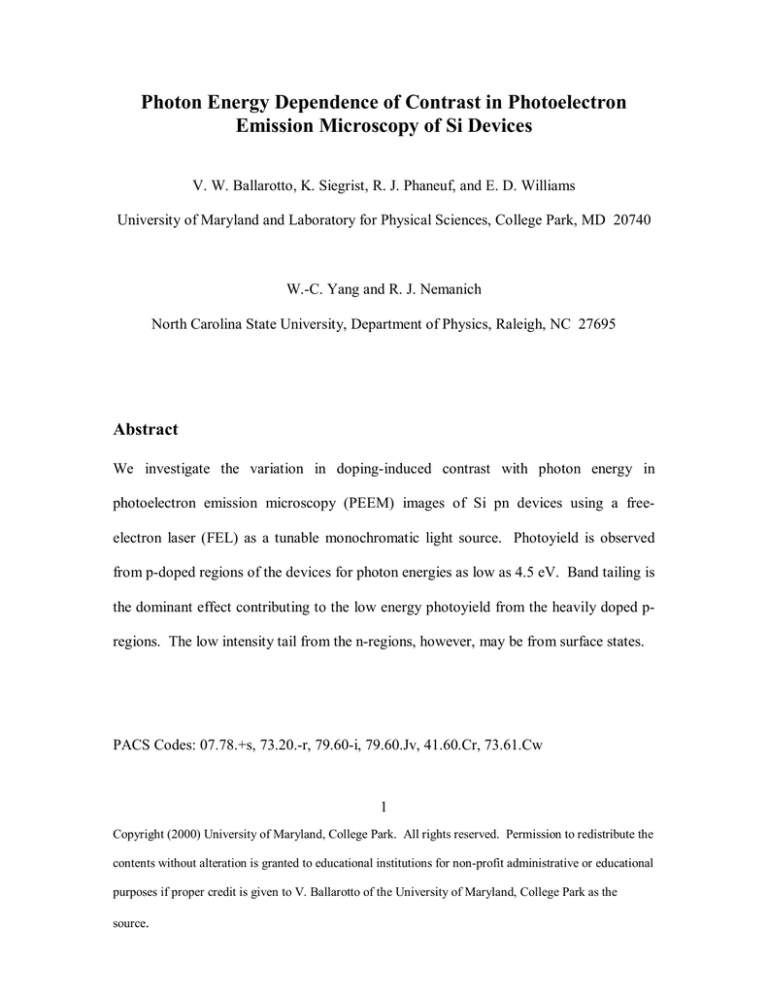
Photon Energy Dependence of Contrast in Photoelectron
Emission Microscopy of Si Devices
V. W. Ballarotto, K. Siegrist, R. J. Phaneuf, and E. D. Williams
University of Maryland and Laboratory for Physical Sciences, College Park, MD 20740
W.-C. Yang and R. J. Nemanich
North Carolina State University, Department of Physics, Raleigh, NC 27695
Abstract
We investigate the variation in doping-induced contrast with photon energy in
photoelectron emission microscopy (PEEM) images of Si pn devices using a freeelectron laser (FEL) as a tunable monochromatic light source. Photoyield is observed
from p-doped regions of the devices for photon energies as low as 4.5 eV. Band tailing is
the dominant effect contributing to the low energy photoyield from the heavily doped pregions. The low intensity tail from the n-regions, however, may be from surface states.
PACS Codes: 07.78.+s, 73.20.-r, 79.60-i, 79.60.Jv, 41.60.Cr, 73.61.Cw
1
Copyright (2000) University of Maryland, College Park. All rights reserved. Permission to redistribute the
contents without alteration is granted to educational institutions for non-profit administrative or educational
purposes if proper credit is given to V. Ballarotto of the University of Maryland, College Park as the
source.
We have previously reported that in near-threshold photoelectron emission microscopy
(PEEM), image contrast can arise due to differences in semiconductor bulk doping
concentrations1,2. The dependence of the photothreshold on the amount of doping can be
attributed to surface state associated band bending3. In a p-type semiconductor with
donor-type surface states, the resulting upward band bending generates a depth dependent
photothreshold, which decreases from a maximum value at the surface to a minimum in
the bulk. The depth at which the minimum is reached depends on both the bulk doping
level and distribution of surface states. Using a fixed band gap, simple modeling of
emission from the valence band would suggest that doping contrast in PEEM would
increase by imaging closer to threshold. In this letter, we report on the use of a freeelectron laser (FEL) as a high intensity, tunable monochromatic light source for PEEM
imaging. We find a significantly higher photoyield from heavily doped p-type regions
compared with lightly doped n-regions on Si(001) extends to photon energies at a least a
few tenths of an eV below the conventional threshold, but contrast between different pdoping regions does not improve.
2
Copyright (2000) University of Maryland, College Park. All rights reserved. Permission to redistribute the
contents without alteration is granted to educational institutions for non-profit administrative or educational
purposes if proper credit is given to V. Ballarotto of the University of Maryland, College Park as the
source.
A commercial PEEM (Elmitec) is coupled to the Duke UV FEL. The sample is imaged
in a chamber whose base pressure is 5x10-10 Torr. This system has been described fully
elsewhere4.
Briefly, the microscope includes a magnetic objective lens, a total
magnification of 10,000x and a nominal resolution of approximately 10 nm. The FEL
storage ring5 produces coherent UV radiation in the range of 3.5 to 6.4 eV as well as
spontaneous radiation from IR to soft X-rays. The results here were obtained using
spontaneous radiation in the energy range of 4.5 to 5.2 eV with an average power of
roughly 1mW focused to approximately 10 W/cm2. The typical output spectrum of the
FEL is nearly gaussian with a full-width at half maximum of approximately 0.13 eV.
The samples used for the study were fabricated using a combination of standard
photolithography and focused-ion beam (FIB) writing techniques. A lateral array of pn
junctions was formed by implanting boron ions (1018 cm-3, 190 keV) through a mask into
an n-type Si(001) substrate (P 1014 cm-3). Additional lines were produced using FIB
writing with 120 keV boron ions to allow a systematic variation of the doping levels.
Lines were produced with nominal p-type bulk doping levels of 1018, 1019, 1020 cm-3 and
nominal line widths of 200 nm. Subsequent to implantation the samples were annealed at
1050 °C for 20 minutes to activate the dopants. The average doping level in the sampling
region is different than the bulk value. Using Suprem-IV6, we estimate the near surface
3
Copyright (2000) University of Maryland, College Park. All rights reserved. Permission to redistribute the
contents without alteration is granted to educational institutions for non-profit administrative or educational
purposes if proper credit is given to V. Ballarotto of the University of Maryland, College Park as the
source.
doping levels to be 1017, 1018 and 3x1019 cm-3 for the corresponding bulk values
mentioned above.
No chemical etching was done prior to loading into the PEEM
chamber, and a native oxide was present on the Si surfaces.
To analyze the PEEM intensity from the image data, line scans perpendicular to the
implanted lines were measured for each set of doping levels. In a given image, 20 to 30
parallel scans were averaged to produce an intensity profile across the doped lines of
interest.
A representative PEEM image showing doping contrast is illustrated in the inset of Fig. 1.
The vertical lines are p-type (3x1019 cm-3), generated with FIB writing, and appear much
brighter than the surrounding n-doped substrate. The horizontal lines (p-type 1018 cm-3)
of intermediate intensity were produced with standard broad-beam implantation through a
photolithographically produced mask. Even higher intensity is observed for FIB lines
with concentrations of 1020 cm-3 (not shown, see ref. 1). At this setting of the objective
lens, the FIB lines are in sharp focus, but the photolithography lines are out of focus. To
characterize the contrast seen in figure 1 quantitatively, we acquired images of the
different lines with photon energy from 4.5 to 5.2 eV in steps of 0.1 eV. Figure 1 shows
an example of our results, consisting of intensity scans across PEEM images of a pair of
photolithography lines.
The intensity increases monotonically as the photon energy
4
Copyright (2000) University of Maryland, College Park. All rights reserved. Permission to redistribute the
contents without alteration is granted to educational institutions for non-profit administrative or educational
purposes if proper credit is given to V. Ballarotto of the University of Maryland, College Park as the
source.
increases. The contrast between p- and n- regions is observed for photon energies well
below the nominal photothreshold of 5.1 eV, suggested by Allen and Gobeli for Si(111)3.
Significant intensity from the n regions is visible for hν greater than or equal to 4.8 eV.
The variation in image intensity peak height observed for each of the three different
implantation concentrations is summarized in Fig. 2. The data were normalized to the
calculated photoyield for a dopant concentration Na = 1x1017 cm-3 and a photon energy of
5.2 eV. Both the intensities and the contrast between the n and p regions drop with
decreasing photon energy. The contrast between the p-stripes and the n-doped substrate
remains observable down to 4.9 eV for the 1017 cm-3 stripe, 4.7 eV for the 1018 cm-3 stripe
and 4.5 eV for the 3x1019 cm-3 stripe.
Allen and Gobeli showed that the photothreshold for a cleaved Si(111) surface decreases
when the sample is heavily to degenerately doped3, consistent with the monotonically
increasing photoyield with dopant concentration we observe in Fig. 2.
To make a
quantitative comparison of the observed photon energy dependence of the photoyield
with that expected for electron excitation from the valence band, we perform a standard
model calculation.
The photoyield Y from the valence band for an indirect optical
transition near threshold can be expressed as
Y (hν ) ∝ ∫ (hν − ET (x ))
5/ 2
e − x / l dx
5
Copyright (2000) University of Maryland, College Park. All rights reserved. Permission to redistribute the
contents without alteration is granted to educational institutions for non-profit administrative or educational
purposes if proper credit is given to V. Ballarotto of the University of Maryland, College Park as the
source.
where hν is the photon energy and ET(x) is the photothreshold as a function of bulk depth
x7. The reduced escape depth l = 18 Å is given by 1/l = 1/lα + 1/le where lα (approx. 60
Å) is the absorption length and le (25 Å) is the electron escape depth. The band bending
profile, ET(x>0), is determined by solving Poisson’s equation in the space charge region8.
To determine the normalized surface potential vs (defined as qVs/kT), charge neutrality is
invoked. By solving the neutrality condition as a function of vs, the physically acceptable
value of vs can be determined9. The continuous distribution of surface states for a native
oxide covered Si surface is parabolic10 and centered at branch point energy Eb – Evs =
0.36 eV11. To calculate the photoyield from the p regions, we consider the effect of an
areal surface state density Nsd = 5x1013 cm-2. In this case, the values of vs range from 6.6
to 9.9 for doping levels 1017 to 1020 cm-3. We calculate the p-stripe photoyield using
these values of vs.
For heavily doped silicon, impurity band tailing effects will reduce the band gap12,13
which will also reduce the surface photothreshold, ET(x=0).
Hence, we must treat
ET(x=0) as a function of the bulk doping. For boron doping concentrations of 1018 cm-3
and higher, Wagner has shown that band gap reduction ranges from 50 to 200 meV 12.
The lines plotted with the data points in Fig. 2 show the results of calculations of the pregion photoyield, using the approach outlined by Kane for emission from the valence
6
Copyright (2000) University of Maryland, College Park. All rights reserved. Permission to redistribute the
contents without alteration is granted to educational institutions for non-profit administrative or educational
purposes if proper credit is given to V. Ballarotto of the University of Maryland, College Park as the
source.
band7.
The total calculated photoyield was obtained by integrating Y(hν) over the
distribution function of photon energies characterizing the FEL light source4. A gaussian
distribution of photon energies centered about the desired photon energy with a full-width
at half maximum of 0.13 eV was used as a weighting function in the integration. The
best agreement of the calculated intensity variation with our data was obtained for surface
photothreshold greater than predicted by Wagner.
Using a nominal surface
photothreshold of 4.9 eV, we find that band gap reductions of 25 meV (ET(x=0) = 4.88
eV) and 40 meV (ET(x=0) = 4.86 eV) produce good agreement with our 1018 and 3x1019
cm-3 data, respectively. We did not implement gap reduction for the 1017 cm-3 case since
none is expected. We note that channel plate saturation may have reduced the measured
intensities for 1018 and 3x1019 cm-3 at 5.2 eV.
For the lightly doped n-regions, the sub-threshold intensity is consistent with emission
from occupied surface states.
Low-level intensity would be expected down to
approximately 0.4 eV lower than our best-fit surface photothreshold of 4.9 eV.
In
contrast, surface state emission from p-doped regions would only extend to
approximately 0.2 eV below threshold.
Our previous study1 using a Hg arc lamp (hν ≤ 5.1 eV) produced results which could be
explained reasonably well without considering the effect of impurity band tailing on the
7
Copyright (2000) University of Maryland, College Park. All rights reserved. Permission to redistribute the
contents without alteration is granted to educational institutions for non-profit administrative or educational
purposes if proper credit is given to V. Ballarotto of the University of Maryland, College Park as the
source.
band gap. However, these results, in which we tune the photon energy, demonstrate that
the effect of impurity band tails must be considered to correctly describe the photoyield
data.
In summary, we have investigated the photon energy dependence of doping-induced
contrast in PEEM. By using a tunable light source, we have, unexpectedly, been able to
observe contrast between heavily p-doped regions and the lightly n-doped Si(100)
substrate for photon energies as low as 4.5 eV. A simple model calculation of valence
band emission from the p-regions, which includes the effects of impurity band tailing and
surface state associated band bending, gives good agreement with our intensity data. We
attribute the low-level intensity from the lightly n-doped substrate to surface state
photoemission.
The authors thank the Duke University Free Electron Laboratory for access to the OK-4
UV FEL and the FEL staff for their assistance.
This work was supported by the
Laboratory for Physical Science. W-CY and RJN acknowledge the support of the Office
of Naval Research.
8
Copyright (2000) University of Maryland, College Park. All rights reserved. Permission to redistribute the
contents without alteration is granted to educational institutions for non-profit administrative or educational
purposes if proper credit is given to V. Ballarotto of the University of Maryland, College Park as the
source.
References
1
V. W. Ballarotto, K. Siegrist, R. J. Phaneuf, and E. D. Williams, Surf. Sci. Lett. 461,
L570 (2000).
2
M. Giesen, R. J. Phaneuf, E. D. Williams, T. L. Einstein, and H. Ibach, Appl. Phys. A-
Mater. 64, 423 (1997).
3
F. G. Allen and G. W. Gobeli, Phys. Rev. 127, 150 (1962).
4
H. Ade, W. Yang, S. L. English, J. Hartman, R. F. Davis, R. J. Nemanich, V. N.
Litvinenko, I. V. Pinayev, Y. Wu, and J. M. Madey, Surf. Rev. Lett. 5, 1257 (1998).
5
V. N. Litvinenko, B. Burnham, J. M. J. Madey, S. H. Park, and Y. Wu, Nucl. Instrum.
Methods Phys. Rev. A375, 46 (1996).
6
Computer code Suprem-IV, Stanford University, Palo Alto, CA. Calculates 1- and 2-D
implant profiles with pre- and post-annealing simulations.
7
E. O. Kane, Phys. Rev. 127, 131 (1962).
8
H. Lüth, Surfaces and Interfaces of Solid Materials, 3th edition (Springer, Berlin,
1995), Chap. 7
9
W. Mönch, Semiconducting Surfaces and Interfaces, 2nd edition (Springer, Berlin,
1995), Chap. 2
10
H. Angermann, W. Henrion, M. Rebien, D. Fischer, J.-T. Zettler, and A. Roseler,
Thin Solid Films 313-314, 552 (1998).
9
Copyright (2000) University of Maryland, College Park. All rights reserved. Permission to redistribute the
contents without alteration is granted to educational institutions for non-profit administrative or educational
purposes if proper credit is given to V. Ballarotto of the University of Maryland, College Park as the
source.
11
J. Tersoff, Phys. Rev. Lett 52, 465 (1984).
12
J. Wagner, Phys. Rev. B 29, 2002 (1984).
13
S. T. Pantelides, A. Selloni, and R. Car, Solid State Electronics 28, 17 (1985).
10
Copyright (2000) University of Maryland, College Park. All rights reserved. Permission to redistribute the
contents without alteration is granted to educational institutions for non-profit administrative or educational
purposes if proper credit is given to V. Ballarotto of the University of Maryland, College Park as the
source.
FIG. 1. PEEM intensity line scans of photolithography lines measured at different values
of incident photon energy. Inset: PEEM image obtained with photon energy of 5.2 eV
and displayed with a field of view of 50 um. The vertical lines are p-type (3x1019 cm-3)
FIB lines. The horizontal lines are p-type (1018 cm-3) photolithography lines.
11
Copyright (2000) University of Maryland, College Park. All rights reserved. Permission to redistribute the
contents without alteration is granted to educational institutions for non-profit administrative or educational
purposes if proper credit is given to V. Ballarotto of the University of Maryland, College Park as the
source.
FIG. 2. Photoyield intensity as a function of photon energy. The symbols are measured
values of PEEM intensity normalized to obtain agreement between measurement and
calculation at 5.2 eV and Na = 1017 cm-3. The curves show calculated intensity from the
valence band.
12
Copyright (2000) University of Maryland, College Park. All rights reserved. Permission to redistribute the
contents without alteration is granted to educational institutions for non-profit administrative or educational
purposes if proper credit is given to V. Ballarotto of the University of Maryland, College Park as the
source.





